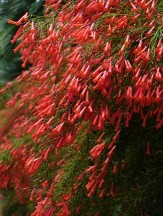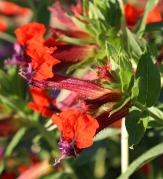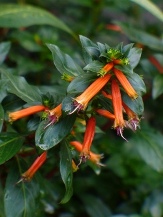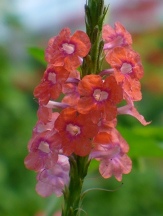The Ins and Outs of Fertilizing Your Plants to Keep Them Happy and Healthy
The Ins and Outs of Fertilizing Plants to Keep them Happy and Healthy
When should I fertilize my plants?
- When should you start fertilizing and when should you quit?
- The general rule of thumb is that plants typically need more available nutrients during the growing season and may not require much, if any, during their natural rest period, if it exists. Here in zone 8B, in west central Louisiana, our last average frost date is around March 1st and our average first frost date is about mid-November. We begin fertilizing hardy woody species and hardy winter and spring growing perennials during late winter or early spring (mid-February to early March) or up to about 6 weeks before their natural growth cycle begins. We generally want to stop fertilizing in time to give these plants a minimum of 6 weeks for growth to begin to slow and for them to begin to naturally harden off before the first expected hard frosts or freezes occur. Here in zone 8B that works out to about midsummer and should be done no later than mid-August. Note: Apply any slow- or controlled-release fertilizers early enough in the year that they will be basically depleted by this time.
- Why does it matter when you fertilize?
- Vigorous tender late season growth can be susceptible to freezing temperatures even for what might seem the hardiest of species. The freeze damage that can occur can actually do much more harm than good by splitting bark and causing die-back on what would normally be reliably hardy species. The wounds caused by split bark, stems, and foliage can also provide an avenue for pests and diseases to enter a normally problem free, pest resistant plant. Often, the results are not aesthetically pleasing and you may have to “admire” your handiwork until spring new growth hides it if you don’t end up losing the plant(s) altogether.
- Do I need to fertilize my plants?
- Plants that are happily growing, flowering, and or fruiting may not require fertilizing every year. Under optimum conditions, natural soils in combination with appropriate organic mulches, mycorrhizal fungi (about 95% of plant species are considered to have associations with mycorrhizal fungi) and soil microbes, additional nutrients may not even be necessary.
- If your plants do not seem to be growing as vigorously as they should during their natural growing period, are not flowering or fruiting sufficiently once mature and are well-established, or if a woody plant has a lot of fuzzy grayish moss-like lichen growing on its bark, your soil may be lacking in nutrients. Normally, if a woody plant is actively growing vigorously enough, they will naturally shed a certain amount of their outermost bark and so the fuzzy lichens fall to the ground and don't get a chance to build up to any noticeable size. Lichen are not harmful and will happily grow on a rock, post, or log as they will your plant's stems. Soil compaction can also limit plant growth and may imitate a lack of available nutrients. Soil compaction can be overcome with a proper organic mulch potentially in combination with fertilizer, along with time for soil microbes to get back to work making the soil friable.
- Containerized plants are solely dependent on the gardener for nutrients. Some potting soils may contain some nutrients initially, but it too will eventually be depleted. These plants are solely dependent on us to provide the necessary nutrients in order for them to grow and thrive.
A Basic Guide as to When to Fertilize Different Types of Plants
|
Plant Type |
Examples |
Begin Fertilization as Early As |
End Fertilization |
|
Reliably Hardy Woody Trees, Shrubs, and Vines |
Azaleas, Camellias, Hollies, Vitex, Honeysuckles, Akebia |
Late winter or early spring |
Midsummer or 4-6 weeks prior to the end of the growing season. About mid-August for zone 8 |
|
Spring or Summer Growing Annuals, Perennials, and Biennials |
Impatiens, Coleus, Petunias, Baptisias, Salvias, Hardy Hibiscus |
Late winter or early spring or at planting time for annuals. |
Midsummer or 4-6 weeks prior to the end of the growing season. About mid-August for zone 8 |
|
Tropicals grown as Die-back Perennials or “Tender Perennials” |
Angel Trumpets, Lantanas, Passionvines, and other marginally hardy species |
Once spring growth commences. March to June depending on your zone. |
Midsummer or 4-6 weeks prior to the end of the growing season. About mid-August for zone 8 |
|
Fall and Winter Growing Perennials, Annuals, and Biennials |
Daffodils, Louisiana Irises, Phlox |
Fall or early winter |
Mid to late spring or once flowering has completed |
|
Tropical Plants grown under warm tropical conditions |
Tropical Hibiscus, Passion Vines, Crossandras |
During their growing season which may be year round for many tropicals. |
About 4-6 weeks before the end of their natural growing season if there is one |
What to fertilize your plants with?
When you receive plants from Almost Eden, you may notice small yellowish to clear BB-sized pellets in or on the plant’s soil. We have used Scott’s Osmocote® with an NPK of 14-14-14 for flowering plants for over 40 years in the nursery business both in our soil mix and as a top dress, when necessary, with excellent results. In fact, we do not use anything else in our own gardens. You can find it in most of the big box stores and at most nurseries and it is labeled as Osmocote® Smart-Release® Plant Food: Flower and Vegetable. There is no doubt that it is more expensive than standard quick release garden fertilizers like 8-8-8, 12-12-12, 13-13-13, etc. The biggest advantage to a controlled-release fertilizer, a.k.a slow- or timed-release, is that each time you water, or it rains, your plants are getting fed for the next few months after application. Full disclosure: we neither sell fertilizer, nor do we reap any type of reward like discounts, etc. for touting Osmocote’s® proven reliability as a garden and nursery fertilizer.
Another advantage of controlled-release fertilizers is that they typically will not ‘burn’ the tender roots of your plants the way that quick release garden fertilizers can if they are accidentally applied too heavily. When we still owned the nursery and garden center Bonny Plants, located in DeRidder, Louisiana, we would travel to nurseries south of New Orleans in the Belle Chase area to buy young grafted, potted citrus trees for resale, like Satsumas. More than once we have seen these 3-gallon sized citrus plants with a ¼-½” layer of Osmocote® on top of the soil and they were growing like gangbusters and were super dark green. You might say that seems wasteful, IMHO, Osmocote® is so expensive that these nurseries would not be able to easily afford being wasteful with it when growing thousands of trees. It was more likely based on plant nutrient requirements as a mature, bearing sized citrus tree can utilize 10-15lbs. of actual nitrogen per year. For comparison, to reach 12 lbs. of nitrogen(N) you would have to apply 150lbs. of 8-8-8 per tree to achieve the necessary nitrogen requirements per year.
Let’s take a moment to better understand the “guaranteed analysis” or percentage of N-P-K on a fertilizer bag. This is the percentage, or ratio, of macronutrients in the bag. For example, if you have 50 lbs. of a 14-14-14 fertilizer there will be: 14% nitrogen (N), 14% phosphorous (P) a.k.a Phosphate, and 14% potassium (K) a.k.a Potash. We know that in 100 lbs. there will be 14 lbs. of each of the N-P-K. That means that in a 50 lb. bag there will be 7 lbs. of N, 7 lbs. of P, and 7 lbs. of K for a total of 21 lbs. The remaining 29 lbs. is typically an inert filler in the case of Osmocote®. Bulk feed store garden fertilizers, usually sold in ratios like 8-8-8, 12-12-12, or 13-13-13, and in areas of the country that have acidic soils, the fertilize blenders for the feed stores will typically use lime as a filler since many garden vegetables prefer a mildly acidic soil. Per Rutgers University, tomatoes and peppers have an optimal soil pH range of 6.0-6.5 and locally our soils are in the 5.0-5.5, acidic to very acidic. By using lime as a filler that helps to push the pH up closer to that range, and the effect is generally only temporary and so the lime must be applied annually to maintain this optimum range. The slightly higher pH and the availability of Calcium helps to ensure that there is plenty of that micronutrient available to help to fight things like blossom end rot and generally promotes an overall healthier, more vigorous, and hopefully more productive plant.
So adding lime in the form of Calcium carbonate to the soil is great right?
Not for acid loving plants like Blueberries, Azaleas, Camellias, Japanese Maples, Hollies, etc. Lime can actually become toxic to these species and the quick release fertilizers can also damage the fine or tender roots of these plants. It may also potentially harm the mycorrhizal fungi that these plants need, and with whom they live in symbiosis with, to do well. You can quite literally kill these acid-loving plants with an innocent application of standard garden fertilizer. Fortunately for us, Osmocote® 14-14-14 does not use lime as a filler and so does not affect the soil’s pH properties making it safe for nearly every plant that we grow. With maybe the exception of epiphytic orchids and some of the more sensitive gesneriads like African violets and Episcias.
Osmocote® and many other fertilizers come in an array of formulations and so how do you know which one to select?
It depends on a few things like are the plants growing in the ground or in containers. In containers, the plant is limited to what we as the gardener supply in the form of nutrients, as the plant is totally dependent on us for food. Some potting soils or potting media may have fertilizers pre-blended into the soil mix but most do not. Potting media can be totally devoid of much in the way of any available nutrients and so this is why you see many ‘balanced’ fertilizers with even NPK ratios, as they can supply all of the necessary macronutrients for your potted plants.
For planting in the ground, the best money you can spend is to get a proper soil test from a reliable source, like what so many of the state cooperative extension services offer. This is the only reliable way to know what nutrients are actually available to your plants in your particular soil. The LSU AgCenter says “Test. Don’t guess!”. At high levels, certain nutrients, like Phosphorous, can become toxic for some plant types. For example, many Australian species, like Eucalyptus and Bottlebrush, can be quite sensitive to phosphorous toxicity.
From the soil test you should be able to determine what formulation will be best suited for your soil and growing conditions and how much to apply. It may also save you money as you are purchasing only the materials that you need. A proper soil test not only benefits your plants, but also your bottom line, the environment, and thus peace of mind as well.
The formulation that you use will also depend on what types of plants you are growing and what their specific needs are. Like the aforementioned citrus that need large amounts of available nitrogen or the acid-loving blueberries that cannot tolerate lime. The general rule for containers is to use a balanced fertilizer for flowering and fruiting plants. For evergreens you might use a slower release, higher nitrogen fertilizer, like Osmocote® 18-6-12, and since this formulation lasts for about 8-9 months it should only need to be applied once in late winter or early spring and you will know that your plants are being fed throughout the growing season.
What about the liquid fertilizers like the popular Miracle-Gro®?
The standard All-Purpose Miracle-Gro® has an NPK of 24-8-16 which is great for giving plants a quick boost but it generally needs to be reapplied every 2 weeks or so during the growing season to be maximally effective. One advantage of liquid fertilizers is that the foliage has the ability to absorb a small amount of nutrients and so it can help to quickly green up plants that may be nitrogen deficient.
The Miracle-Gro® All-Purpose formulation also contains the following trace amounts of micronutrients: Boron(.02%), Copper(.07%), Manganese(.05%), and Iron(.15%). These are some of the main micronutrients, a.k.a. trace elements, that can cause nutrient deficiencies, particularly in containerized plants. You can also find standard and slow release granular fertilizer blends that contain micronutrients, like Osmocote® Smart-Release® Plant Food Plus Outdoor & Indoor with an NPK of 15-9-12 and that lasts up to 6 months. Micronutrients are also available to purchase separately if that is all your soil or potting media is lacking.
How or where should granular and/or liquid fertilizers be applied?
The old rule of thumb for fertilizer is to apply it evenly over the outer 2/3’s of the plant’s root zone and inside the plant’s dripline as this is where the ‘feeder roots’ tend to be. The dripline is an imaginary circle located at the outermost edge of the plant's foliage. If it was straight up noon and the sun is directly overhead, this would basically be the shadow created by that plant. For plants in containers, you still want to keep any granular fertilizers away from the plant stems and it is still typically distributed over the outer 2/3's of the potting soil.
You will nearly always use at least some fertilizer at planting or repotting/uppotting time. Mix the fertilize into the soil that will be worked back in around the root zone of the plant. Do not place fertilizer directly against the roots or the stems of the plant as it could potentially burn them.
With established plants, you cannot easily work the fertilizer into the soil as you would disturb and break many tender roots. In this case, you will want to use granular fertilizers as a top dress, preferably below any mulch but it can also be washed into the mulch while watering the fertilizer in. Always water thoroughly after fertilizing plants with a granular fertilizer. This will properly dilute the fertilizer so that it does not burn any tender roots and so the dissolved fertilizer can then flow into the root zone with the water for uptake by the feeder roots.
Organic vs. Chemical Fertilizers
There are a wide array of organic fertilizers and blends on the market today. And this time I'm going to direct you to the August 2022 GNO article from LSU AgCenter by Dr. Joe Willis: Plant Nutrition Part 2 – Organic vs Chemical Fertilizers & Crop-Specific Fertilizers or if you want to start at the top here is part I from the July 2022 GNO issue: Plant Nutrition Part 1: Understanding N-P-K
Note: As with pesticide usage, we would still direct you to read and follow the label on the fertilizer bag or container. Usage outside of the normal range of the instructions may be harmful to and may potentially kill young plants and the more sensitive species of plants. Using more fertilizer than necessary may not only be costly and wasteful, it can also negatively affect the environment.






